FETHİYE | BODRUM
FETHİYE | Bodrum
Day 1 Fethiye, Kızıl Island, Ağa Limanı:
Fethiye is a natural harbor city in the western Mediterranean. It’s a very popular holiday center with its magnificent natural beauty and ancient Lycian towns. Oludeniz considered the most beautiful beach in Turkey is nearby, and it is a popular place to start a blue voyage yacht cruise.If all places and all seas were known by a colour, Fethiye’s colour would be turquoise. The word turquoise, a blue that has more than a hint of green, comes from the blue used in the Turkish tile work. The most beautiful shade of the colour blue came and settled on the waters of the Ölüdeniz (Dead Sea). Towards evening, around sunset, you catch such a wonderful turquoise you can never see on any other seas. If you call it blue you are wrong, if you say it is green it is not that either but both together. It is difficult to put it into words. It is best if you go and see it for yourself and be hit by a lightening bolt!
At sunset, the sun hits the stones and turns crimson red in color, a color that resembles the island soil. The island got its name from this phenomenon. There is very little infrastructure on this island. The southern tip of the island has a lighthouse that guides maritime traffic. To the north-west are the Deliktas Islands, ideal for diving and fishing. The red waves off the east coast of the island wash the wide sand beach and are best suited for swimming.
Near the tip of the Cape of Kurtoğlu in the Gulf of Fethiye, you would be tempted to dock at what consists of the twin bays of Aga Limani. As a Network Port, it allows you to relax, swim, fish, or take a long walk on the beach. The sea is so clean it here and water is cool becasue of a underwater source close to the beach.
Follow the path to the bay for about an hour to reach the ancient Lycian city of Lyda.
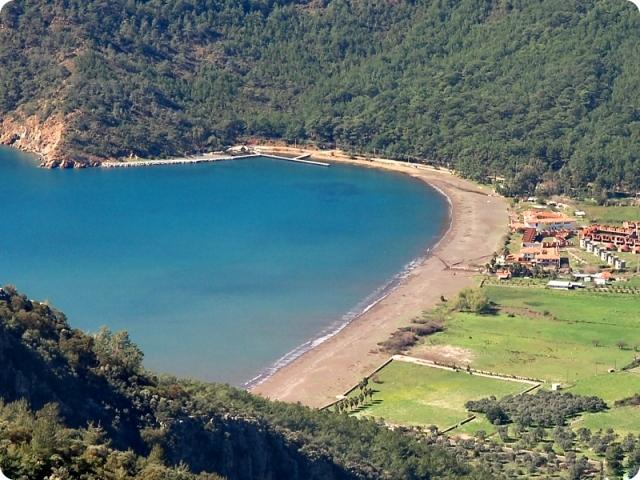 Day 2 Ekincik, Dalyan:
Day 2 Ekincik, Dalyan:
Ekincik is an unspoiled natural wonder, blessed with breathtaking beauty. It is uncrowded, pretty and tranquil with a nice little beach nearby. The coastal road there is gorgeous too and is a good base for boat trips and walking tours.The 2 km long stretch of the unspoilt gravel beach meets a small harbor from which the boats departs to Dalyan, located approximately 45 minutes away. The scenery is stunning and there are many opportunities to observe the local wildlife. On the beach there is a small range of water sports facilities available including banana-boat and water-ski.You may join optional Dalyan Tour from here. You will be taken from your yacht by a small boat called “piyade”. Firstly arrive at Caretta-Caretta (turtle) beach and a take a swim stop here. You will enjoy the natural beauty of the delta as you sail along in the river boat. You will see the ancient Rock Tombs and finally arrive at mud baths to relax and be rejuvenated.
Dalyan is one of the most interesting places of outstanding natural beauty. Set on the south west corner of Turkey’s Mediterranean coast, Dalyan is an unspoilt village surrounded by pine-clad hills, cotton fields and miles of untouched coastline. There are astonishing rock tombs carved out of the local cliffs 2,500 years ago. There are thermal springs and mud bath near Dalyan. The warm water softens the skin and eliminates wrinkles because it contains high ratio sulphur. Dalyan is one of the few surviving places of paradise, an area of natural beauty and historical interest. The ancient city of Caunos lies here with its ruins dating back to 3000 years. This is also the beach where the endangered Loggerhead Turtle (Caretta Caretta) and the green turtle (Chelonia Mydas) have returned to lay their eggs since the beginning of time. The nesting time is from May till October.
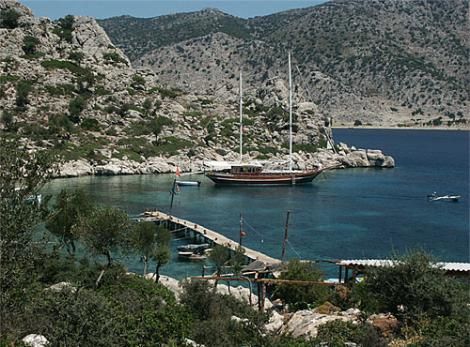 Day 3 Bozukkale:
Day 3 Bozukkale:
Bozukkale (Loryma) is an ancient city that dates back to 10 BC. There are nine towers of the castle walls extending in a mutually rectangular pattern. The castle and towers are very well preserved and appear in a solid state. ‘Kale’ means ‘corrupted’. Therefore, the name of the place may be attributed to the fact that one side of the castle is missing. Bozukale used to serve as a bay cruise stretch for British naval ships and is now considered as a shipyard on the shore. It was used as a place to watch all the yachts in theAegean. Its strategic geographical location and narrow port was also used by the ships sailing from theportofAthens. In 395 BC, the Athenian commander, Karori, is known to have come here. Before the Cnidus War of 305 BC, Demetrios, son of Antigonos chose this port for preparations before attacking Rhodes.
Bozburun is renowned for the thriving sponge business and gullet yacht construction industry. Some of the best wood and craftsmen for building strong and beautiful gullet boats are to be found in this region, which is why leading names in the business employ Bozburun’s boat makers. Owing to its gullet and yacht manufacturing industries, Bozburun has become a central attraction, visited by tourists from all across the world.
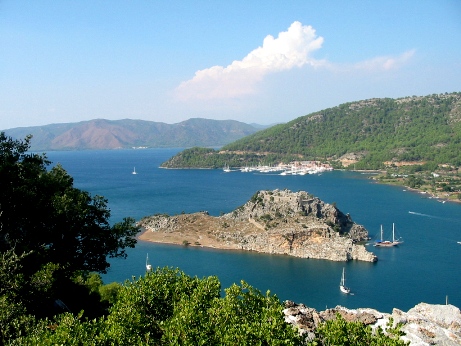 Day 4 Selimiye Bay, Orhaniye Bay:
Day 4 Selimiye Bay, Orhaniye Bay:
The Selimiye village in the Mugla district of Marmaris is one of the pearls of the Gulf of Hisaronu. The ancient name of this village was Hydas, which got changed to Losta. At sunset, the sun disappearing behind the mountains surrounding the village seems to dye the scenery in a rich red hue. The ancient site of Bybossos Hydas (Selimiye) has ruins dating back to the archaic period. One of the highest hills of the region is in Selimiye, the other one at the top of Sarikaya and the last one has three castle ruins, including the Kızılköy Aşarkale Quarter. The sheep-shaped southeastern hills are visited by foreign tourists looking to explore the castle ruins dating back to the Hellenistic era. The tomb in the southern part of the square is located 100 meters offshore from the coast and shows ships the way to the Selimiye. Other areas of interest include a monitoring tower, a lighthouse, a monastery and a theater.American underwater archeologists and scientists are engaged in researching sunken wrecks in the region and have produced valuable findings that are now exhibited in the Bodrum Underwater Museum. Selimiye is frequented by the Blue Cruise boats. Selimiye – Hisaronu – Orhaniye are like an indispensable trio. Selmiye is also renowned for its clean sea water, a great bounty of fish, vegetables, fruits, almond and olive trees, the smell of fresh thyme and oregano enveloping the mountains, clean, pollution-free air, peaceful environment and warm people.
Featuring its deep blue sea and the legendary Kizkumu beach, Orhaniye is well admired by all holidaymakers. Take a journey down it’s quaint village roads to discover the historic castle of the black knight. Floating in this bay, the yachts present a picturesque scene. Thevillage of Orhaniye has lots to offer to a hungry tourist. Enjoy walking down the village or witness the beauty of the busy docks accessed by local and foreign yachtsmen alike, stay indoors or explore the local culture and cuisine of the place – Orhaniye is full of surprises!
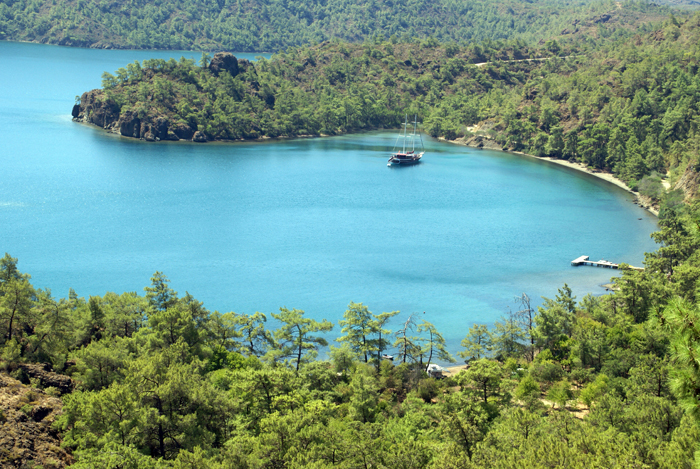 Day 5 Bencik Bay, Datça:
Day 5 Bencik Bay, Datça:
Just across the bay from Selimiye, Bencik offers a quiet and protected anchorage in amongst a pine forest. It is possible to get ashore on to a grassed area, but there are no facilities. Bencik Bay which has a very narrow entrance but a unique view once you get inside. Bencik is located at the narrowest part of the peninsula that divides Hisaronu Gulf from the Gokova Gulf but it is located at Hisaronu side.
Datca was founded by the Dorians settled in the Aegean islands and the southern coast ofIonia. This peninsula is located between the Aegean Sea and theMediterranean Sea. At the end of the peninsula, at a distance of about 38 kms is the ancient Carian city of Knidos, which was described by Strabo as the ‘city built for the most beautiful goddess, Aphrodite, on the most beautiful peninsula”. It is also believed that around 500 years ago, the Spanish pirates sailing left leprosy patients to die here but the fair weather of the peninsula recovered the lepers! You may take a walk in Datca Harbor.
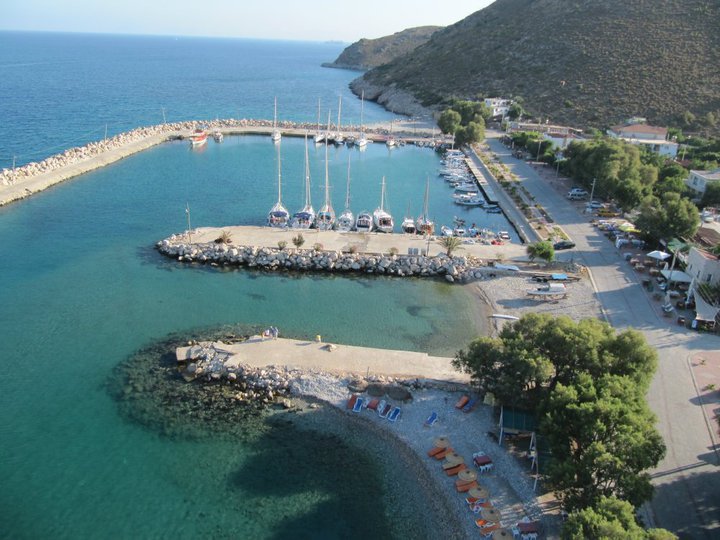 Day 6 Palamutbükü, Knidus:
Day 6 Palamutbükü, Knidus:
Palamutbuku is reputed for having the best beaches in the Datca peninsula. The beaches are small but very beautiful. Surrounded by mountains and spotted with gardens, these beaches are known for their tranquility and fresh sea air that together present the perfect backdrop for a rejuvenating getaway. Palamutbuku is located at the end of the peninsula and is also famed for the remains of the historic city of Knidos. Knidos, known for its bounty of fish, is located about 12 kilometers away.The waters here are crystal clear, so much so that it is believed that if you take a needle at the very bottom of the sea, you can still see it! Go on a sea tour or simply bask on the beaches, watching vibrant birds take a flight – there is so much to do in Palamutbuku! The people are warm and friendly. Palamutbuku epitomizes peace, tranquility and happiness. With its warm people with their smiling faces and immense natural beauty, Palamutbuku is indeed a little paradise in its own right.
Knidos is one of the most magnificent ancient cities in Anatolia that you should visit. As the first settlement in the east of the Datca peninsula, Knidos has splendid ruins and a unique beauty. There is a theater is located right next to the harbor of the ancient city of Knidos. A short walk towards the harbor will take you to the remains of two churches built during the Byzantine period. Knidos century has been a site of archaeological excavations since 1960. The Statue of Demeter discovered here and the lion statues that protected the harbor in ancient times now adorn the halls of the British Museum. The sacred temple of the goddess Aphrodite is a major center of attraction. The city with a huge necropolis, a double harbor and the magnificent acropolis with the temple of Aphrodite truly impresses all visitors.
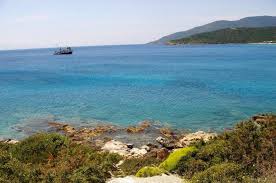 Day 7 Orak Island, Yalıçiftlik:
Day 7 Orak Island, Yalıçiftlik:
Orak Island, located 10 miles to the east of Bodrum, is famous for its rich marine life and crystal blue waters. It is a popular point where yachts and boats on Gokova tours do not pass without stopping. The island stretches opposite of the Kargicik Inlet and has indented shores covered with olive trees in the lower slopes of the hills. There is no settlement on the island but there are sheltered coves that you can anchor at in the north. To its east, the sea looks like an aquarium. Tea will be served in Yaliciftlik Bay. An optional village tour can be arranged from this bay for those who are wishing to experience the local life.
Yaliciftlik is located outside of Bodrum peninsula and 30 km from the city center. It is surrounded by secluded small bays, crystal clear sea and beautiful pine forests. Through beautiful pine forests on a winding road past whitewashed cisterns is the beach at Yaliciftlik. This shingle beach has several restaurants and cafes around it, serving good inexpensive delicious foods. The eastern end of the beach is sandy and it is possible to swim and sunbathe in solitude by the rocks a bit further on. Yaliciftlik is probably one of the best preserved place around the peninsula of Bodrum. Untouched by tourism, the village offers an interesting insight into real local farming life.
Day 8 Bodrum:
Bodrum is the ideal starting point for sailing the Aegean coast of Turkey. The Gökova Gulf is acknowledged to be one of the best cruising areas in Europe. With abundant sunshine, crystal clear waters, continuous blue skies, good anchorages and friendly people, this coast offers many diversities. There are many unspoiled areas rich in natural beauty and in costal settlements and villages.Bodrum is a port city in Muğla Province, in the southwestern Aegean Region of Turkey. It is located on the southern coast of Bodrum Peninsula, at a point that checks the entry into the Gulf of Gökova. The city was called Halicarnassus of Caria in ancient times and was famous for housing the Mausoleum of Mausolus, one of the Seven Wonders of the Ancient World. Bodrum Castle, built by the Crusaders in the 15th century, overlooks the harbour and the marina. The castle grounds include a Museum of Underwater Archeology and hosts several cultural festivals throughout the year.